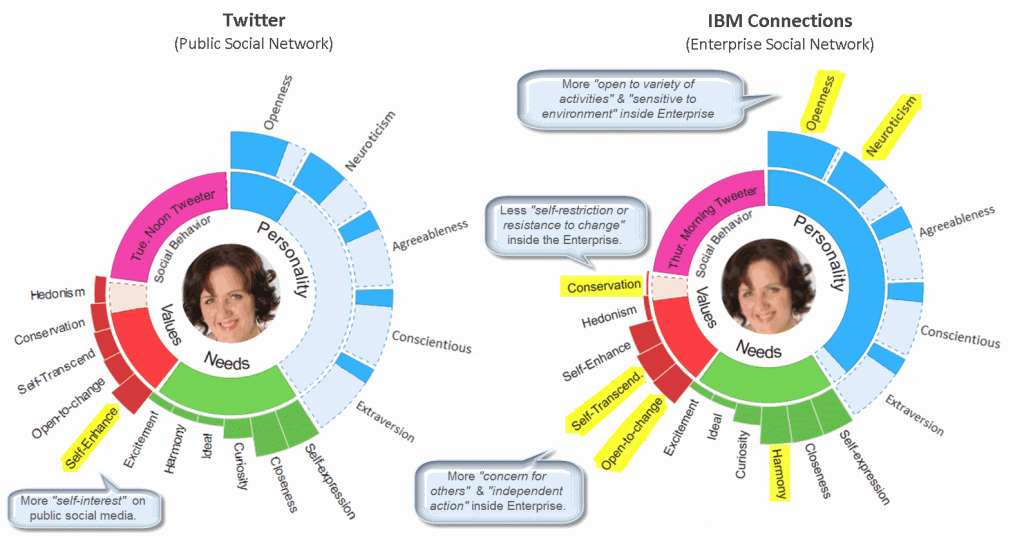One of the fun parts of working for IBM is that I get to collaborate with a diverse community of researchers spread across the globe. Most recently I’ve been fortunate enough to participate in a study, run by the IBM Almaden Research Center, using their latest social analytics research technology called System-U which does psychometric analysis of social media content. For more check out a recent Venturebeat article entitled IBM researcher can decipher your personality from looking at 200 of your tweets).
System-U breaks its analysis down into the following groups of characteristics:
- Personality: Psychological characteristics that differentiate one individual from another; currently modelled on the Big Five Personality Traits.
- Basic Human Values: A person’s belief and motivators, where someone could hold numerous values but with varying degrees of importance; currently includes 6 dimensions of human values based on the work of Professor Shalom Schwartz.
- Fundamental Human Needs: A person’s fundamental needs; currently based on Maslow’s hierarchy of needs, as well as Ford’s work on Marketing and consumer-related needs modeling.
- Emotional Style: A measure of how a person’s emotional states look like and change. This helps us answer questions such as what is the emotional outlook of an individual and how resilient a person is emotionally.
Now before anyone cries “Big Brother” this was a completely opt-in study and, at least for me, was more of a learning tool to help me understand how I may be perceived through the different social channels. Also, since I am active on both public (Twitter) and enterprise (IBM Connections) social networks, it allowed me to examine the differences that may exist between the environments. I’ve always firmly believed that people are different inside and outside the enterprise since the drivers for engagement are very different, therefore I was really interested to see if the analysis validated this.
So in the name of social sharing… I am going to bare all and share my own personal analysis results. And I apologize in advance to my fellow tweeters for being a bit high on the “Self-Enhance” dimension when on Twitter. I’m sure that’s one piece of insight that won’t surprise anyone :-)
Before explaining what this all means, let’s start with some definitions:
- Hedonism: seeking pleasure and sensuous gratification for oneself.
- Conservation: emphasizing self-restriction, order and resistance to change.
- Self-transcend: showing concern for the welfare and interests of others.
- Open-to-change: emphasizing independent action, thought, feeling, and readiness for new experience.
- Self-Enhance: seeking personal success for oneself.
- Excitement: getting out there and living life, upbeat emotions, and having fun.
- Harmony: appreciating other people, their viewpoints and their feelings.
- Ideal: a desire for perfection and a sense of community.
- Curiosity: a desire to discover, find out and grow.
- Closeness: being connected to family and setting up home.
- Self-expression: discovering and asserting one’s own identity.
- Openness: the extent to which a person is open to experience a variety of activities.
- Neuroticism: the extent to which a person’s emotion is sensitive to the environment.
- Conscientiousness: a tendency that a person acts in an organized or spontaneous way.
- Extraversion: a tendency to seek stimulation in the company of others.
- Agreeableness: a tendency to be compassionate and coorperative towards others.
Now for some observations that I thought were interesting:
- All in all, despite being very different data sources, my personality pretty much consistently came across the same, which is what I would have expected. I’m still Marie Wallace, warts and all, no matter where I am. However there were some distinctive differences between my public and enterprise personas.
- When inside the enterprise it would appear that I am much more thoughtful about the community, about other people’s needs, opinions, emotions, … and things are much less about self-promotion and more about collaboration. Now I don’t believe it says that I’m a total ego-maniac on Twitter, but it does indicate that I am perhaps less sensitive than on the enterprise network. Something I promise to work on fellow tweeters :)
- What was a bit surprising, was that I measure as being more open to new ideas and activities inside the enterprise. Now maybe this isn’t hugely surprising if you think about the collaborative nature of the ESN.
- What did initially surprise me was that I measured as being more conservative on the external networks? But again I suppose that inside the enterprise you are in a “warm nest”, among friends where you are incentivized to take risks and openly share opinion; whereas externally there may be an element of “not wanting to get egg on your face in public”.
All in all I really enjoyed being part of this analytics project and firmly believe that this type of analytics can play a role in the broader social media analytics space. It just needs to be managed thoughtfully and not used to exploit people.
